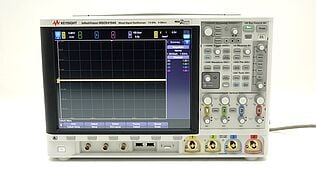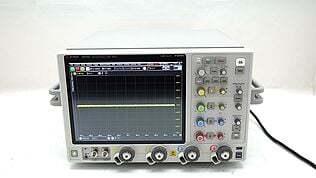- Introduction
- What is an Electron Beam?
- The Formation of the Electron Beam
- Journey Inside the Oscilloscope
- Deflection Plates and Coils
- Phosphor Screen
- Electron Beam Characteristics
- Velocity
- Focus
- Key Features and Impacts of Electron Beams in Oscilloscopes
- Conclusion
- Whenever You’re Ready, Here Are 5 Ways We Can Help You
Did you know that the electron beam in a cathode ray oscilloscope moves at approximately a tenth the speed of light?
For electrical engineers and professionals working with oscilloscopes, understanding the electron beam is pivotal.
This article delves into what an electron beam is, how it functions within an oscilloscope, and why it's vital for signal analysis.
What is an Electron Beam?
An electron beam is a concentrated flow of electrons that moves at high speeds, often a substantial fraction of the speed of light. Generated within an oscilloscope, it travels through a carefully engineered path influenced by electric and magnetic fields.
The beam plays a pivotal role in creating the visual display of waveforms, as its characteristics directly affect the accuracy, resolution, and brightness of the signals being measured.
| Key Takeaway |
|---|
| The electron beam in an oscilloscope is pivotal for generating accurate and clear waveform displays, with its characteristics like high velocity and focus directly influencing measurement quality. Understanding these properties can significantly improve oscilloscope performance and signal analysis. |
The Formation of the Electron Beam
To comprehend the role of the electron beam in an oscilloscope, we first need to understand how the beam forms and what components play key roles in this process.
Cathode Emission
The initiation of the electron beam starts with cathode emission. Here, a cathode element, usually made of tungsten or a similar material, heats up to a high temperature.
This thermal excitation frees the outer electrons from the atomic structure of the cathode, facilitating their movement into the surrounding space.
Space Charge
As a result of cathode emission, a cloud of free electrons, known as a "space charge," accumulates around the heated cathode.
These electrons have a natural tendency to repel each other due to their like charges, but the thermal energy from the cathode keeps them in a cloud-like formation close to the surface.
Anode Acceleration
Opposite the cathode, an anode plate carrying a positive charge sits within the vacuum tube. This anode attracts the negatively charged electrons from the space charge region.
As the electrons accelerate towards the anode, they gain kinetic energy proportional to the voltage difference between the cathode and the anode.
This acceleration is crucial for achieving the high velocity needed for the electron beam to strike the phosphor screen with sufficient energy to produce a visible trace.
Tiny Aperture
The anode structure contains a tiny aperture, or hole, that serves as a gateway for the accelerated electrons.
As the electrons rush toward the anode, only those that pass through this aperture form the electron beam.
This aperture essentially acts as a "filter," ensuring that the electrons are in a straight line as they travel through the vacuum tube. The size and shape of the aperture influence the focus and overall quality of the electron beam.
The formation of the electron beam in an oscilloscope involves a meticulous process, orchestrated by a series of finely-tuned components.
These components work in harmony to generate, accelerate, and direct the electron beam, which ultimately provides the visual representation of electrical signals.
Buy Refurbished Oscilloscopes On Sale
Journey Inside the Oscilloscope
Once the electron beam exits the anode aperture, it navigates through a series of critical components within the oscilloscope.
These components modify and guide the beam in a way that allows it to accurately display the waveform you're measuring.
Deflection Plates and Coils
- Vertical deflection: Two horizontally-aligned plates or coils generate an electric or magnetic field that influences the vertical position of the electron beam. The vertical deflection system is directly tied to the input signal you're trying to measure.
As the input signal's voltage varies, the field between the vertical deflection plates changes accordingly. This alteration in the field causes the electron beam to move up or down, faithfully tracing the input signal's waveform. - Horizontal deflection: A similar but independent set of plates or coils control the horizontal movement of the electron beam.
In contrast to the vertical system, the horizontal deflection usually operates at a constant rate determined by the time-base setting of the oscilloscope.
This constant horizontal sweep allows the vertical signal to be plotted against time, generating the waveform you see on the screen.
Phosphor Screen
The culmination of this intricate process occurs when the finely-tuned electron beam hits the phosphor screen at the end of the tube. Here's how the screen factors into resolution and brightness:
- Resolution: The clarity of the displayed waveform relies heavily on the focus of the electron beam. Precise electromagnetic lenses along the beam's path narrow it down, resulting in a finer point of impact on the phosphor screen.
This fine point enables higher resolution and a more accurate representation of the input signal. Poor focus, conversely, would cause the beam to strike a larger area on the screen, blurring the displayed waveform. - Brightness: The luminosity of the display is a function of the beam's velocity and density as it strikes the phosphor screen. Higher velocities and denser beams excite more phosphor particles, producing a brighter glow.
The speed and density of the beam are, in turn, influenced by the accelerating voltage and current supplied to the cathode and anode.

Electron Beam Characteristics
Analyzing the characteristics of the electron beam offers a lens into the performance capabilities and limitations of oscilloscopes.
Two pivotal aspects—velocity and focus—play central roles in determining the quality of the displayed waveform.
Velocity
- High-speed: The electron beam achieves remarkable speeds, often traveling at a significant fraction of the speed of light. This high speed is essential for several reasons.
First, it ensures that the beam reaches the phosphor screen with enough energy to generate a visible display.
Second, the rapid movement enables the display of fast-changing signals, meeting the requirements for high-frequency applications. - Energy: The kinetic energy of the accelerated electrons is directly proportional to the voltage difference between the cathode and the anode.
Higher accelerating voltages result in higher beam speeds, which in turn affect the brightness and resolution of the display.
Engineers often have to balance this kinetic energy with other parameters like focus and deflection sensitivity, especially when dealing with complex or minute signals.
Focus
- Electromagnetic lenses: Special electromagnetic lenses situated along the electron beam's path serve a vital purpose: they focus the beam into a narrow, fine-pointed form.
These lenses work by generating magnetic fields that pull the diverging electron paths back toward the center. The result is a highly-focused beam, capable of rendering precise and clear waveforms on the phosphor screen. - Astigmatism: Proper focusing is crucial for eliminating astigmatism, a condition where the electron beam doesn't focus into a symmetrical point, leading to distorted waveform displays.
Astigmatism can occur due to misalignments or imperfections in the electromagnetic lenses or deflection plates.
Most oscilloscopes have built-in astigmatism correction features, allowing engineers to manually adjust the focus until the beam forms a symmetrical point, thereby ensuring an accurate representation of the measured signal.
Understanding the intricacies of electron beam characteristics not only deepens our appreciation of oscilloscope technology but also aids in making informed decisions when troubleshooting or optimizing waveform displays.
Key Features and Impacts of Electron Beams in Oscilloscopes
| Electron Beam Characteristics | Role in Oscilloscope | Impact on Waveform Quality | Considerations for Engineers |
| Velocity | Beam acceleration | Affects brightness | Higher velocity may require fine-tuning of focus |
| Energy | Beam acceleration | Affects resolution | Balance kinetic energy with focus and deflection sensitivity |
| Focus | Waveform clarity | Affects resolution | Ensure electromagnetic lenses are properly aligned for optimal focus |
| Astigmatism | Waveform symmetry | Can distort waveform | Use built-in astigmatism correction features |
| Vertical Deflection | Signal representation | Affects accuracy | Calibrate regularly to match input signal |
| Horizontal Deflection | Time-base | Affects timing accuracy | Verify time-base settings for signal frequency |
Browse Our Refurbished Oscilloscope Selection
Select up to 3 instruments to compare
Enable Notifications
In order to use this feature, you need to enable notifications.
Manage notification preferences
Conclusion
From the meticulous formation of the electron beam to its journey through deflection plates and ultimately to the phosphor screen, understanding the mechanics and characteristics of electron beams reveals a fascinating world within oscilloscopes.
Such insights not only deepen our appreciation for this indispensable tool but also guide engineers in optimizing waveform displays, achieving accurate measurements, and making informed decisions when troubleshooting.
Whether you're a seasoned engineer or a professional just starting in the field, the need for reliable and high-performance oscilloscopes is paramount. That's why choosing the right equipment, which balances performance, reliability, and cost, can make all the difference in your work.
If you're in the market for premium quality, yet affordable, oscilloscopes, function generators, signal analyzers, or meters, look no further than the Keysight Used Equipment Store.
Our premium used equipment undergoes rigorous testing and certification to ensure it meets the high standards you've come to expect from new Keysight products.
Don't compromise on quality when you can get superior performance at a fraction of the cost.

Whenever You’re Ready, Here Are 5 Ways We Can Help You
- Browse our Premium Used Oscilloscopes.
- Call tech support US: +1 800 829-4444
Press #, then 2. Hours: 7 am – 5 pm MT, Mon– Fri - Talk to our sales support team by clicking the icon (bottom right corner) on every offer page
- Create an account to get price alerts and access to exclusive waitlists.
- Talk to your account manager about your specific needs.












































